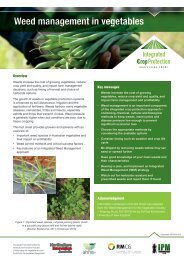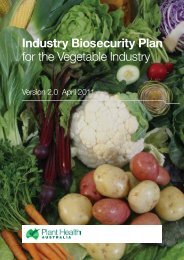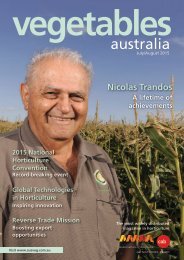vegetables
VA-NovDec2015
VA-NovDec2015
Create successful ePaper yourself
Turn your PDF publications into a flip-book with our unique Google optimized e-Paper software.
16<br />
Biosecurity Brief<br />
R&D<br />
Market &<br />
Value Chain<br />
Development<br />
with Dr Kevin<br />
Clayton-Greene<br />
THROUGHOUT THIS YEAR, THE BIOSECURITY BRIEF HAS INVESTIGATED THE<br />
EMERGENCY PLANT PEST RESPONSE DEED (THE DEED) AND MECHANISMS FOR<br />
ERADICATING EMERGENCY PLANT PESTS UNDER THE DEED. WITH A FLURRY OF<br />
EXOTIC PLANT PEST INCURSIONS OVER 2014 AND 2015, BIOSECURITY ADVISER DR<br />
KEVIN CLAYTON-GREENE TAKES A LOOK AT EMERGENCY PLANT PEST RESPONSE<br />
LEVIES – WHAT THEY ARE AND HOW THEY CAN BE USED TO BENEFIT INDUSTRY.<br />
Cost benefit analyses often<br />
find that eradication of a<br />
pest is more beneficial than<br />
long-term management, as<br />
long as the pest distribution is<br />
delimited to a contained region<br />
and adequate control options<br />
are available.<br />
However, eradication of plant<br />
pests in Australia is commonly<br />
becoming a joint cost sharing<br />
arrangement between industry<br />
and government under the<br />
Emergency Plant Pest Response<br />
(EPPR) Deed. Within industry,<br />
one method of meeting cost<br />
sharing obligations is to raise an<br />
EPPR levy.<br />
What is the maximum<br />
cost of an eradication<br />
response to industry?<br />
The Deed contains provisions<br />
for signatories, such as<br />
AUSVEG, to agree on a ‘ceiling’<br />
to the amount that will be<br />
eligible for cost sharing during<br />
an eradication. This is known as<br />
the Agreed Limit and can only<br />
be exceeded with the written<br />
agreement of the Affected<br />
Parties.<br />
Under the Deed, EPPs are<br />
organised into four categories<br />
that determine the cost sharing<br />
split between government and<br />
affected industry parties, based<br />
on the public versus private<br />
benefit of eradication. These<br />
categories are a reflection of<br />
where the EPP would impact<br />
should it become established.<br />
Category one: 100 per cent<br />
government.<br />
Category two: 80 per cent<br />
government, 20 per cent<br />
industry.<br />
Category three: 50 per cent<br />
government, 50 per cent<br />
industry.<br />
Category four: 20 per cent<br />
government, 80 per cent<br />
industry.<br />
How does industry<br />
meet its cost sharing<br />
obligation?<br />
The EPPR Levy option became<br />
available since amendments<br />
to the Plant Health Australia<br />
(Plant Industries) Funding Act<br />
2002 commenced on 22 June<br />
2006. If an industry agrees to<br />
contribute to an eradication, an<br />
EPPR levy can be established<br />
to meet financial liabilities for<br />
responses under the Deed.<br />
How does the levy work?<br />
If a majority of industry<br />
participants support the levy or<br />
charge proposal, the industry<br />
body submits the proposal to<br />
the Federal Government for<br />
consideration. If approved, the<br />
levy or charge is imposed and<br />
collected under legislation.<br />
Industries may elect to set the<br />
levy rate at zero, to be activated<br />
in the event of an EPP response<br />
or at a positive level. Apart from<br />
an EPP eradication, an EPPR<br />
levy may also set the levy at<br />
a positive rate to undertake<br />
biosecurity risk mitigation<br />
activities, such as surveillance<br />
and research related to EPPs.<br />
How are EPPR levy funds<br />
managed?<br />
The Federal Government will<br />
collect and forward to Plant<br />
Health Australia (PHA) amounts<br />
raised by the EPPR levy.<br />
PHA is required to hold the<br />
payments for each participating<br />
plant industry in a separate<br />
fund. The accumulated funds<br />
may be applied to biosecurity<br />
activities where support has<br />
been provided by the industry<br />
in accordance with the Federal<br />
Government Levy Principles.<br />
How are EPPR levies<br />
currently used?<br />
Some industries, such as the<br />
vegetable industry, already<br />
have an EPPR levy in place set<br />
at zero, while other industries<br />
have raised their EPPR levy to<br />
a positive value to aid industry<br />
biosecurity preparedness or<br />
contribute to pest eradication.<br />
Some examples of industries<br />
with a positive EPPR levy are<br />
included below.<br />
• The banana industry has an<br />
EPPR levy in place to pay the<br />
industry share for eradication of<br />
Banana freckle in the Northern<br />
Territory. The current EPPR rate<br />
is 0.75 cents per kilogram.<br />
• The mango industry has<br />
an EPPR levy of 0.114 cents<br />
per kilogram that is to be used<br />
for biosecurity preparedness<br />
purposes.<br />
• The honey bee industry<br />
has an EPPR levy in place<br />
at 2.9 cents per kilogram as<br />
a preparedness measure for<br />
incursions of high priority pests<br />
such as Varroa mite, which has<br />
not yet been found in Australia.<br />
Specifically, the levy will fund<br />
development of the National<br />
Bee Biosecurity Program.<br />
i<br />
For more information,<br />
contact AUSVEG.<br />
Phone: (03) 9882 0277<br />
Email: info@ausveg.com.au





